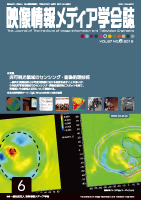Volume 67, Issue 6
Displaying 1-22 of 22 articles from this issue
- |<
- <
- 1
- >
- >|
Focus
-
2013Volume 67Issue 6 Pages k14
Published: 2013
Released on J-STAGE: June 01, 2015
Download PDF (346K)
Special Issue
Sensing and Image Processing Techniques in the Non-visible Light Field
-
2013Volume 67Issue 6 Pages 447-450
Published: 2013
Released on J-STAGE: June 01, 2015
Download PDF (2209K) -
2013Volume 67Issue 6 Pages 451-455
Published: 2013
Released on J-STAGE: June 01, 2015
Download PDF (355K) -
2013Volume 67Issue 6 Pages 456-459
Published: 2013
Released on J-STAGE: June 01, 2015
Download PDF (1174K) -
2013Volume 67Issue 6 Pages 460-464
Published: 2013
Released on J-STAGE: June 01, 2015
Download PDF (457K) -
2013Volume 67Issue 6 Pages 465-467
Published: 2013
Released on J-STAGE: June 01, 2015
Download PDF (481K) -
2013Volume 67Issue 6 Pages 468-472
Published: 2013
Released on J-STAGE: June 01, 2015
Download PDF (883K)
Topcis
-
2013Volume 67Issue 6 Pages 473-476
Published: 2013
Released on J-STAGE: June 01, 2015
Download PDF (903K)
Technical Guide
Basic Technologies of Image Coding(11,The Last Chaper)
-
2013Volume 67Issue 6 Pages 477-481
Published: 2013
Released on J-STAGE: June 01, 2015
Download PDF (747K) -
2013Volume 67Issue 6 Pages 482-486
Published: 2013
Released on J-STAGE: June 01, 2015
Download PDF (764K)
ITE Review 2013 Series(6)
-
2013Volume 67Issue 6 Pages 487-492
Published: 2013
Released on J-STAGE: June 01, 2015
Download PDF (1083K)
Keywords you should know(89)
-
2013Volume 67Issue 6 Pages 493-495
Published: 2013
Released on J-STAGE: June 01, 2015
Download PDF (633K)
My Recommendations on Research and Development Tools (69)
-
2013Volume 67Issue 6 Pages 496-499
Published: 2013
Released on J-STAGE: June 01, 2015
Download PDF (1029K)
News
-
2013Volume 67Issue 6 Pages 500-502
Published: 2013
Released on J-STAGE: June 01, 2015
Download PDF (275K) -
2013Volume 67Issue 6 Pages 503-504
Published: 2013
Released on J-STAGE: June 01, 2015
Download PDF (260K)
-
2013Volume 67Issue 6 Pages J155-J162
Published: 2013
Released on J-STAGE: May 24, 2013
Download PDF (1872K) -
2013Volume 67Issue 6 Pages J163-J170
Published: 2013
Released on J-STAGE: May 24, 2013
Download PDF (2468K) -
2013Volume 67Issue 6 Pages J171-J179
Published: 2013
Released on J-STAGE: May 24, 2013
Download PDF (1363K) -
CosmicAI: Generating Sky Images Through Content-Based Search, Flexible Composition, and Work Sharing2013Volume 67Issue 6 Pages J180-J185
Published: 2013
Released on J-STAGE: May 24, 2013
Download PDF (1018K)
-
2013Volume 67Issue 6 Pages J186-J189
Published: 2013
Released on J-STAGE: May 24, 2013
Download PDF (886K) -
2013Volume 67Issue 6 Pages J190-J193
Published: 2013
Released on J-STAGE: May 24, 2013
Download PDF (1777K)
-
2013Volume 67Issue 6 Pages J194-J203
Published: 2013
Released on J-STAGE: May 24, 2013
Download PDF (3066K)
- |<
- <
- 1
- >
- >|
